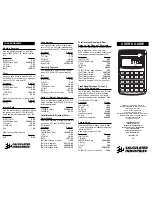
1-10 Operating the TI
-
83
8301OPER.DOC TI-83 international English Bob Fedorisko Revised: 02/19/01 12:09 PM Printed: 02/19/01 1:34
PM Page 10 of 24
Notation modes only affect the way an answer is displayed
on the home screen. Numeric answers can be displayed
with up to 10 digits and a two-digit exponent. You can
enter a number in any format.
Normal
notation mode is the usual way we express
numbers, with digits to the left and right of the decimal, as
in
12345.67
.
Sci
(scientific) notation mode expresses numbers in two
parts. The significant digits display with one digit to the left
of the decimal. The appropriate power of 10 displays to the
right of
E
, as in
1.234567
E
4
.
Eng
(engineering) notation mode is similar to scientific
notation. However, the number can have one, two, or three
digits before the decimal; and the power-of-10 exponent is
a multiple of three, as in
12.34567
E
3
.
Note: If you select
Normal
notation, but the answer cannot display in
10 digits (or the absolute value is less than .001), the TI
.
83 expresses
the answer in scientific notation.
Float
(floating) decimal mode displays up to 10 digits, plus
the sign and decimal.
0123456789
(fixed) decimal mode specifies the number of
digits (
0
through
9
) to display to the right of the decimal.
Place the cursor on the desired number of decimal digits,
and then press
Í
.
The decimal setting applies to
Normal
,
Sci
, and
Eng
notation modes.
The decimal setting applies to these numbers:
•
An answer displayed on the home screen
•
Coordinates on a graph (Chapters 3, 4, 5, and 6)
•
The
Tangent(
DRAW
instruction equation of the line,
x
,
and
dy/dx
values (Chapter 8)
•
Results of
CALCULATE
operations (Chapters 3, 4, 5,
and 6)
•
The regression equation stored after the execution of a
regression model (Chapter 12)
Normal, Sci, Eng
Float,
0123456789











































